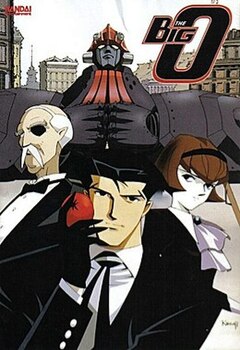Paradigm City
| The Big O | |

Cover art for The Big O Complete Collection DVD release by Bandai Entertainment
|
|
|
THE ビッグオー (Za Biggu Ō) |
|
|---|---|
| Genre | Mecha, neo-noir, tech-noir |
| Anime television series | |
| Directed by | Kazuyoshi Katayama |
| Produced by | Atsushi Sugita Chieo Ohashi Eiji Sashita |
| Written by | Chiaki J. Konaka |
| Music by | Toshihiko Sahashi |
| Studio | Sunrise |
| Licensed by | |
| Original network | WOWOW |
| English network | |
| Original run | 13 October 1999 – 19 January 2000 |
| Episodes | 13 |
| Anime television series | |
| The Big O II | |
| Directed by |
Kazuyoshi Katayama Lia Sargent (co-director) |
| Produced by | Charles McCarter Atsushi Sugita Chieo Ohashi Eiji Sashita |
| Written by | Chiaki J. Konaka |
| Music by | Toshihiko Sahashi |
| Studio |
Sunrise Cartoon Network Studios |
| Licensed by | |
| Original network | WOWOW |
| English network | |
| Original run | 2 January 2003 – 23 March 2003 |
| Episodes | 13 |
| Manga | |
| Written by | Hitoshi Ariga |
| Published by | Kodansha |
| English publisher | |
| Demographic | Seinen |
| Magazine | Magazine Z |
| Original run | July 1999 – October 2001 |
| Volumes | 6 |
| Manga | |
| The Big O: Lost Memory | |
| Written by | Hitoshi Ariga |
| Published by | Kodansha |
| Demographic | Seinen |
| Magazine | Magazine Z |
| Original run | November 2002 – September 2003 |
| Volumes | 2 |
The Big O (Japanese: THE ビッグオー Hepburn: Za Biggu Ō?) is a Japanese anime television series created by designer Keiichi Sato and director Kazuyoshi Katayama for Sunrise. The writing staff was assembled by the series' head writer, Chiaki J. Konaka, who is known for his work on Serial Experiments Lain and Hellsing.
The story takes place forty years after a mysterious occurrence causes the residents of Paradigm City to lose their memories. The series follows Roger Smith, Paradigm City's top Negotiator. He provides this "much needed service" with the help of a robot named R. Dorothy Wayneright and his butler Norman Burg. When the need arises, Roger calls upon Big O, a giant relic from the city's past.
The television series is designed as a tribute to Japanese and Western shows from the 1960s and 1970s. The series is done in the style of film noir and combines the feel of a detective show with the mecha genre of anime. The setpieces are reminiscent of tokusatsu productions of the 1950s and 1960s, particularly Toho's kaiju movies, and the score is an eclectic mix of styles and musical homages.
...
Wikipedia
